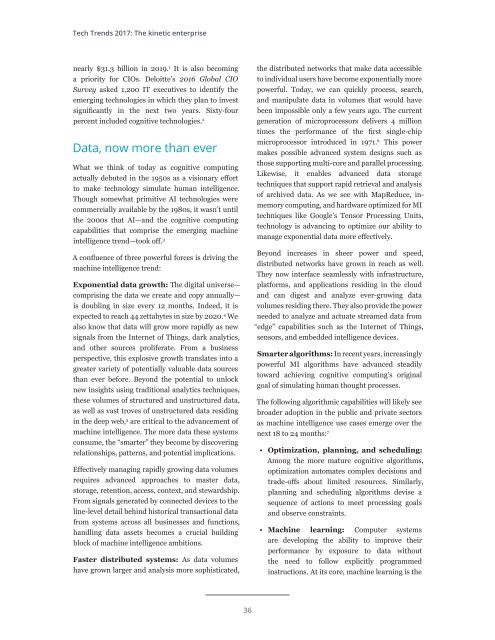Trending the trends Eight years of research
2kcf8xh
2kcf8xh
Create successful ePaper yourself
Turn your PDF publications into a flip-book with our unique Google optimized e-Paper software.
Tech Trends 2017: The kinetic enterprise<br />
nearly $31.3 billion in 2019. 1 It is also becoming<br />
a priority for CIOs. Deloitte’s 2016 Global CIO<br />
Survey asked 1,200 IT executives to identify <strong>the</strong><br />
emerging technologies in which <strong>the</strong>y plan to invest<br />
significantly in <strong>the</strong> next two <strong>years</strong>. Sixty-four<br />
percent included cognitive technologies. 2<br />
Data, now more than ever<br />
What we think <strong>of</strong> today as cognitive computing<br />
actually debuted in <strong>the</strong> 1950s as a visionary effort<br />
to make technology simulate human intelligence.<br />
Though somewhat primitive AI technologies were<br />
commercially available by <strong>the</strong> 1980s, it wasn’t until<br />
<strong>the</strong> 2000s that AI—and <strong>the</strong> cognitive computing<br />
capabilities that comprise <strong>the</strong> emerging machine<br />
intelligence trend—took <strong>of</strong>f. 3<br />
A confluence <strong>of</strong> three powerful forces is driving <strong>the</strong><br />
machine intelligence trend:<br />
Exponential data growth: The digital universe—<br />
comprising <strong>the</strong> data we create and copy annually—<br />
is doubling in size every 12 months. Indeed, it is<br />
expected to reach 44 zettabytes in size by 2020. 4 We<br />
also know that data will grow more rapidly as new<br />
signals from <strong>the</strong> Internet <strong>of</strong> Things, dark analytics,<br />
and o<strong>the</strong>r sources proliferate. From a business<br />
perspective, this explosive growth translates into a<br />
greater variety <strong>of</strong> potentially valuable data sources<br />
than ever before. Beyond <strong>the</strong> potential to unlock<br />
new insights using traditional analytics techniques,<br />
<strong>the</strong>se volumes <strong>of</strong> structured and unstructured data,<br />
as well as vast troves <strong>of</strong> unstructured data residing<br />
in <strong>the</strong> deep web, 5 are critical to <strong>the</strong> advancement <strong>of</strong><br />
machine intelligence. The more data <strong>the</strong>se systems<br />
consume, <strong>the</strong> “smarter” <strong>the</strong>y become by discovering<br />
relationships, patterns, and potential implications.<br />
Effectively managing rapidly growing data volumes<br />
requires advanced approaches to master data,<br />
storage, retention, access, context, and stewardship.<br />
From signals generated by connected devices to <strong>the</strong><br />
line-level detail behind historical transactional data<br />
from systems across all businesses and functions,<br />
handling data assets becomes a crucial building<br />
block <strong>of</strong> machine intelligence ambitions.<br />
Faster distributed systems: As data volumes<br />
have grown larger and analysis more sophisticated,<br />
<strong>the</strong> distributed networks that make data accessible<br />
to individual users have become exponentially more<br />
powerful. Today, we can quickly process, search,<br />
and manipulate data in volumes that would have<br />
been impossible only a few <strong>years</strong> ago. The current<br />
generation <strong>of</strong> microprocessors delivers 4 million<br />
times <strong>the</strong> performance <strong>of</strong> <strong>the</strong> first single-chip<br />
microprocessor introduced in 1971. 6 This power<br />
makes possible advanced system designs such as<br />
those supporting multi-core and parallel processing.<br />
Likewise, it enables advanced data storage<br />
techniques that support rapid retrieval and analysis<br />
<strong>of</strong> archived data. As we see with MapReduce, inmemory<br />
computing, and hardware optimized for MI<br />
techniques like Google’s Tensor Processing Units,<br />
technology is advancing to optimize our ability to<br />
manage exponential data more effectively.<br />
Beyond increases in sheer power and speed,<br />
distributed networks have grown in reach as well.<br />
They now interface seamlessly with infrastructure,<br />
platforms, and applications residing in <strong>the</strong> cloud<br />
and can digest and analyze ever-growing data<br />
volumes residing <strong>the</strong>re. They also provide <strong>the</strong> power<br />
needed to analyze and actuate streamed data from<br />
“edge” capabilities such as <strong>the</strong> Internet <strong>of</strong> Things,<br />
sensors, and embedded intelligence devices.<br />
Smarter algorithms: In recent <strong>years</strong>, increasingly<br />
powerful MI algorithms have advanced steadily<br />
toward achieving cognitive computing’s original<br />
goal <strong>of</strong> simulating human thought processes.<br />
The following algorithmic capabilities will likely see<br />
broader adoption in <strong>the</strong> public and private sectors<br />
as machine intelligence use cases emerge over <strong>the</strong><br />
next 18 to 24 months: 7<br />
• Optimization, planning, and scheduling:<br />
Among <strong>the</strong> more mature cognitive algorithms,<br />
optimization automates complex decisions and<br />
trade-<strong>of</strong>fs about limited resources. Similarly,<br />
planning and scheduling algorithms devise a<br />
sequence <strong>of</strong> actions to meet processing goals<br />
and observe constraints.<br />
• Machine learning: Computer systems<br />
are developing <strong>the</strong> ability to improve <strong>the</strong>ir<br />
performance by exposure to data without<br />
<strong>the</strong> need to follow explicitly programmed<br />
instructions. At its core, machine learning is <strong>the</strong><br />
36


